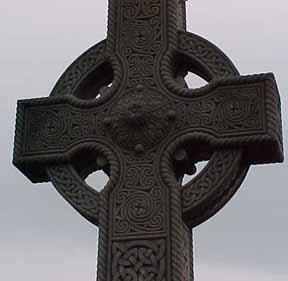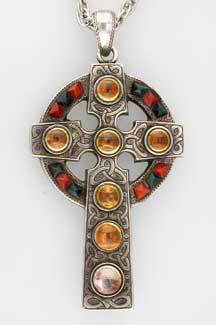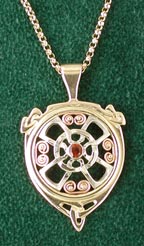|
High Cross Celtic Revival monument to
|
This web page is about the rediscovery and
use of the Celtic Cross, beginning with the Irish Celtic Revival of
the 19th century to the present time.
The cross with a circle has been popularly known as a "Celtic Cross" since around 1850. The form itself evolved between the 4th and 9th century. Also known as "The Irish Cross" or "The Irish High Cross" this type of cross is now associated with Celtic heritage. Use of the phrase "Celtic Cross" is an acknowledgement that the form is not only Irish, but was and is shared by Scotland, Wales, Cornwall and other regions that were influenced by early Celtic Christianity. In the 1840s reproductions of historical Celtic jewelry began to be produced and sold in Ireland. This new interest in native antiquities was the beginning of a renewed interest in past Irish cultural achievements and grew into a literary and artistic movement known as 'The Celtic Revival". In 1853 casts of two historical High Crosses were exhibited with great success at the Dublin Industrial Exhibition. In 1857 Henry O'Neill published Illustrations of the Most Interesting of the Sculptured Crosses of Ancient Ireland. These two events stimulated interest in the Celtic Cross as a symbol for a renewed sense of heritage. New versions of the High Cross quickly became fashionable cemetery monuments in Victorian Dublin in the 1860s. From Dublin the revival spread to the rest of the country and beyond. |
|
The photo on the right shows one of the last of the circle headed crosses of the medieval tradition. This cross on the Scottish Isle of Iona is known as MacLean's Cross and is dated from the 15th century. Decorated with interlaced design this monument and others like it can be said to represent an unbroken tradition that goes back to the earliest days of Christianity in the Celtic lands. From the time of the Protestant Reformation until the Celtic Revival, interlace decoration continued to be used on jewelry and furniture but appears to have ceased in stone carving. The creation of Celtic Crosses almost ceases between 1516 and around 1850. (The only 2 examples I know of during this prolonged drought are the Clanranald Stone on South Uist, 1572 and a cross at Cruicetown, Co. Meath, 1688.If you know of any others, please email me)
|
MacLean's Cross, 15th c.
|





